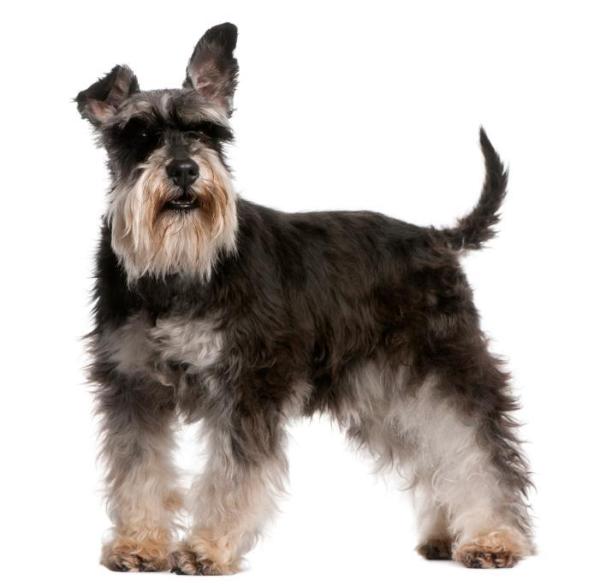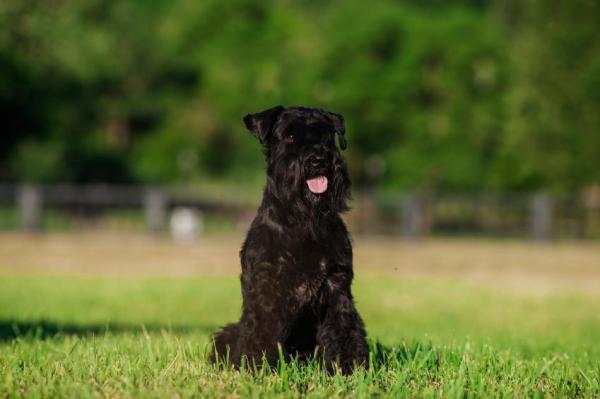
If you're thinking of getting a dog and think that the Schnauzer type is perfect for you, you may be wondering just how big can each breed can grow. In this AnimalWised article we will tell you about the different Schnauzer breeds: Miniature, Standard and Giant.
We'll go over the main differences between the breeds, as well as some interesting facts about their personality, training possibilities and colors. You should know that some Schnauzer dogs are white, although the most common is the salt and pepper Schnauzer. Read on to find out all about them!
Miniature Schnauzer
The Miniature Schnauzer is the reduced or smaller form of the Standard Schnauzer, which we are all very familiar with. In order to achieve this small size, breeders selected especially small specimens for reproduction and sometimes crossed them with smaller breeds like the Affenpinscher, which gave them smaller versions of this dog.
Miniature Schnauzers measure between 30 and 38 cm (12 to 15 in) to the withers and they usually weigh around 5 kilograms (11 lb), never more than 8 (18 lb). This means they are in the list of the smallest dog breeds in the world.

The physical characteristics of Miniature Schnauzers are very similar to those of larger specimens. However, we must point out something about the character of the smaller breed.
Miniature Schnauzers are very active and alert dogs, perfect for people who want to take this sweet animal around with them. For instance, they were originally bred to hunt rats in farms. You should know about the exaggerated behaviors of smaller breeds. They can be great for kids if properly trained through a good socialization.

It is very important to consider where you are going to get a Miniature Schnauzer from. As you'll know, dogs selected to obtain particular offspring usually have hereditary health problems. This is the case because some breeders use dogs which close consanguinity for reproduction, which increases the likelihood of genetic mutations.
Some of the problems that can affect your Miniature Schnauzer are:
- Cataracts
- Cornea defects
- Kidney stones
- Liver problems
- Heart disease
- Diabetes
- Cysts
- Myotonia
You should find an ethical breeder or better still, consider adopting a non-pedigree dog. Whatever your final choice, you should make sure to adopt it responsibly.

Standard Schnauzer
Did you know that Schnauzers were used to control rodent infestations in 19th Century Germany? Despite this, thanks to the character of this beautiful breed, they quickly became excellent companion dogs.
The Standard Schnauzer is a loving and loyal dog, and it's also an excellent watchdog. With this in mind, in the past it was left in charge of horses and mares, and alerted the owners if anyone or anything turned up.

The Standard Schnauzer is a medium-sized dog. It measures between 43 and 50 centimeters (17 to 20 in) to the withers, and usually weighs around 15 or 25 kilograms (30 to 58 lb), with females weighing less than males.
This dog competes for a good place in the rankings of the most intelligent dogs. Owing to their intellectual capacity, Standard Schnauzers are excellent at carrying out various tasks: Rounding up cattle, keeping you company or acting as a watch dog. It has a loyal and sweet character, although it can sometimes appear to be jealous. They will love being looked after and spending time with you.

Giant Schnauzer
The Giant Schnauzer went unnoticed for many years. It was used as a working dog, responsible for guarding factories, breweries or farmyards before being used as a military dog in the Second World War.
They are currently being used as police dogs, but this shouldn't come as a surprise to you: Giant Schnauzers are very intelligent dogs capable of being trained in agility, herding, and search and rescue.

Unlike its smaller siblings, the Giant Schnauzer is somewhat untrusting and territorial with strangers, perhaps due to the selection of specimens with these characteristics in the past.
But it is also a dog that can be trained very easily and with whom your children will play actively and happily. Good training will be essential to enjoy this enormous and generous dog.

White Schnauzer
As we've mentioned, in addition to "salt and pepper" Schnauzers you can also find white Schnauzers. This is one of the variants accepted in the breed standard, but not by the American or Canadian Kennel Clubs.


If you want to read similar articles to Schnauzer Breeds: Miniature, Standard and Giant, we recommend you visit our Comparisons category.
- You should know that it is currently prohibited to cut the tails or ears off a Schnauzer.